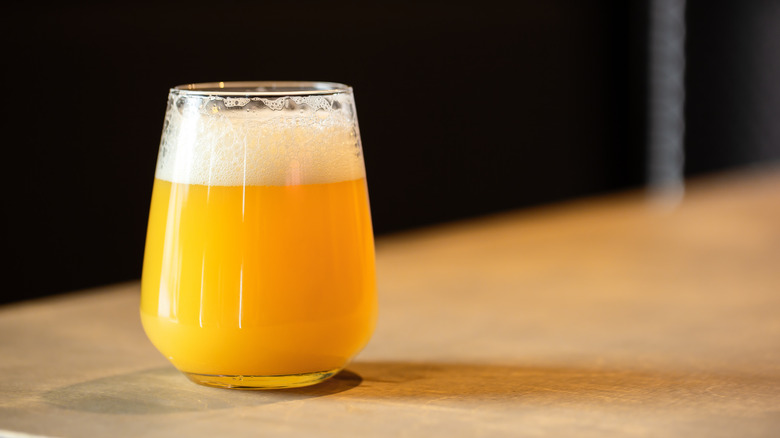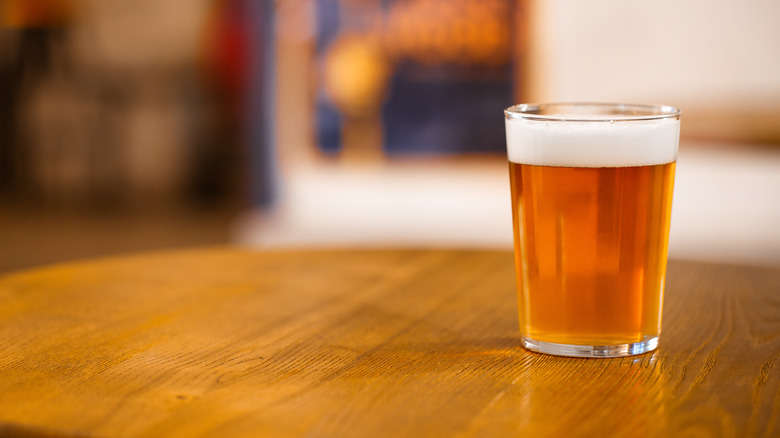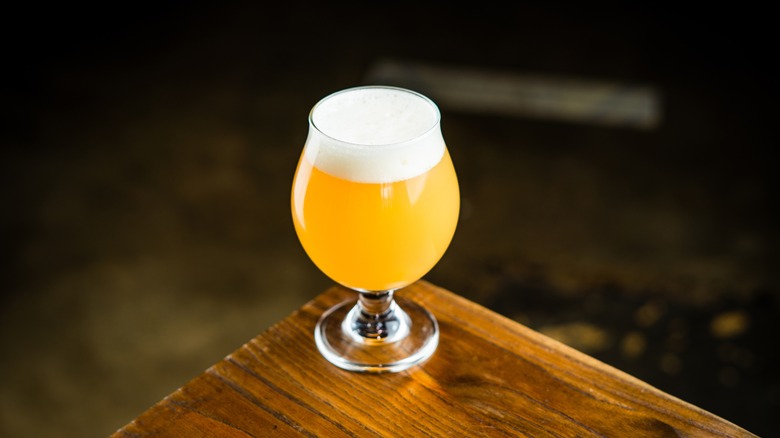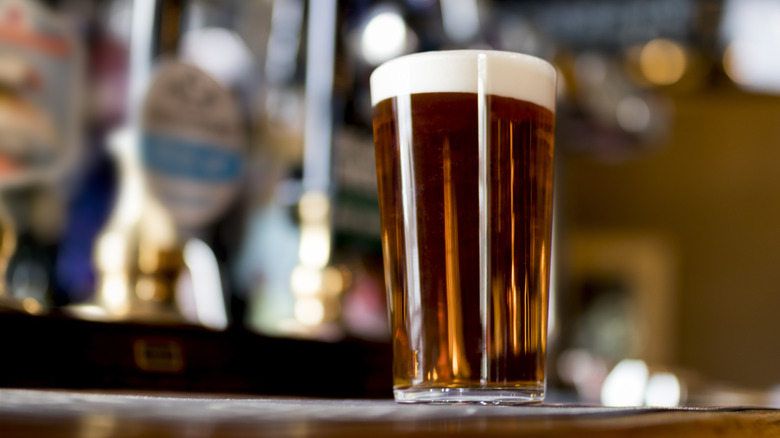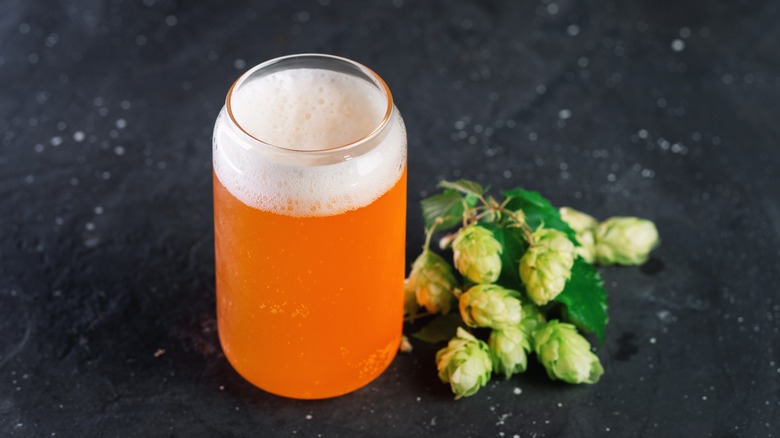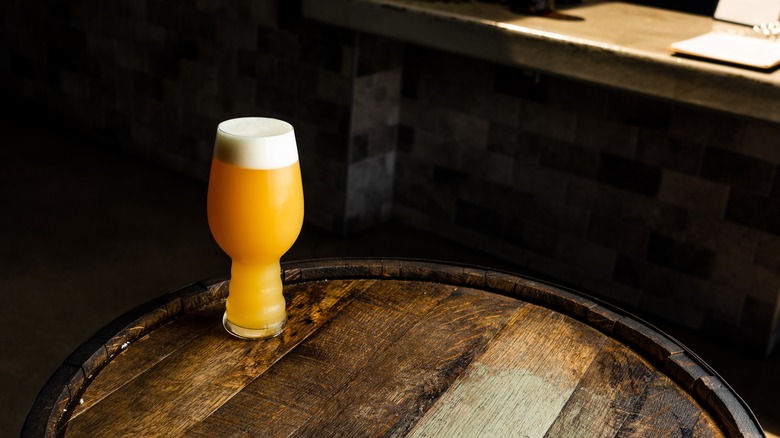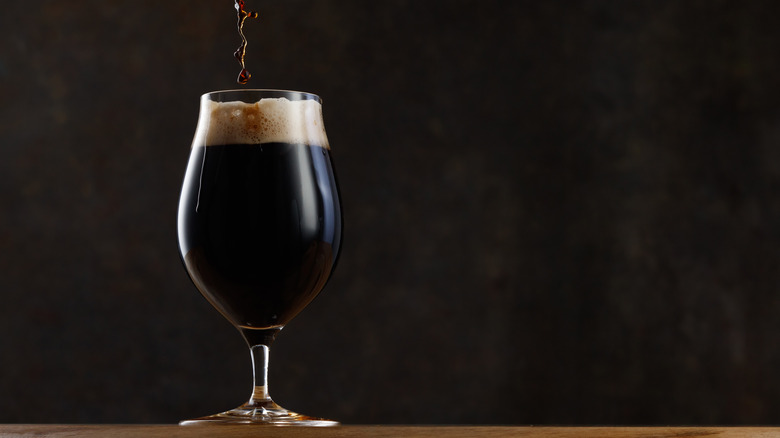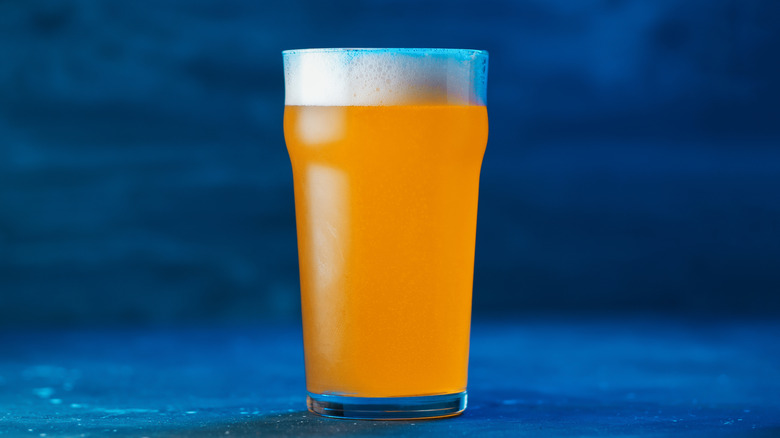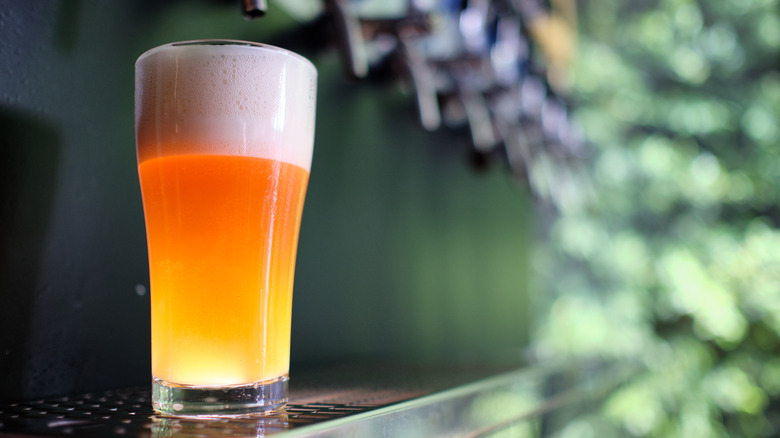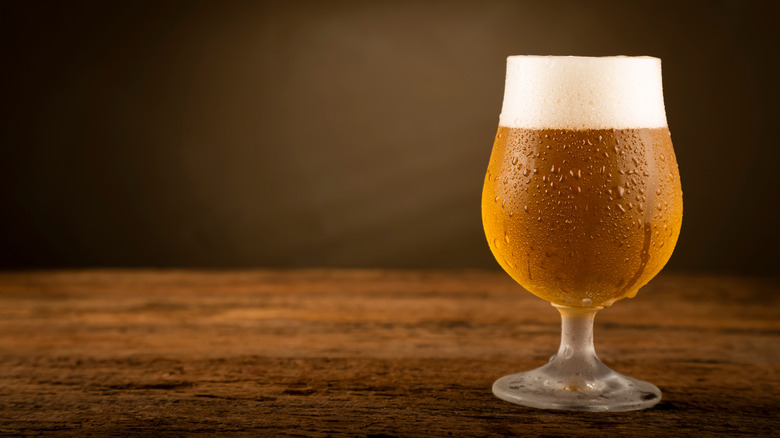Every IPA Style Explained
The craft beer boom has been indisputably fueled, driven, and sustained by the India pale ale. Most often abbreviated IPA and known for its hoppy bitterness, it's the backbone of nearly any craft brewery you visit (via Draft Mag), but this type of beer comes in many styles.
Despite an industry-wide setback during the pandemic, craft beer not only survived but also continues to thrive. In 2021, the volume growth of craft beer increased by 7.9%, following the industry's first-ever decrease the year before (-9%), according to Forbes. Craft beer is dusting itself off and surging ahead with confidence, and there remains plenty to keep both brewers and beer drinkers optimistic. Although the pandemic caused many closings, the number of U.S. craft breweries recorded in 2021 reached 9,247, compared to just 1,813 in 2010.
An outing at a brewery with friends or family is tough to beat, but if you're new to craft beer and IPAs, the menu you find yourself looking at can be daunting. Percentages, types of hops, and unique or bizarre names may seem overwhelming, though a simple understanding of the various types of IPA is all you need to know to give one a fair try. Just as there's a beer out there for everyone, there's an IPA for every taste, too. Once you've found one you like, chances are you'll never stop exploring. Thanks to some help from Kushal Hall, the Director of Operations at Common Space Brewery in Hawthorne, California, here is your guide to getting a head start in the diverse world of IPA styles.
New England IPA
The New England style IPA is probably the most common IPA you'll find at a brewery, restaurant, or in stores. You have most likely also heard of an IPA referred to or labeled as "hazy." This is the same as the New England style, as that is the region where the hazy IPA was first created, according to Hall.
Although the name of this IPA is "New England," the hops used in its products do not necessarily have to be grown or harvested in that region. Developed in Oregon, Cascade hops are a hop variety commonly used in brewing hazy IPAs (via Beer and Brewing), and hops from Australia and New Zealand are also popular because of their tropical notes and sweeter flavors. This is what makes hazy IPAs juicy and not as bitter as others. Flavor notes often attributed to New England IPAs include pineapple, mango, and other bright, sweet flavors instead of more piney, dry resin notes. The ABV of New England IPA typically falls between 6% and 7.5% alcohol by volume, or ABV (via Craft Beer).
Hall recommends this style of IPA to craft beer newcomers and those who do not have much IPA exposure or have had poor experiences in the past. Hazy IPAs are considered the least challenging and most approachable. If you prefer sweeter drinks and worry about the classic hoppy bite of an IPA, the New England IPA is the perfect brew to change your mind.
West Coast IPA
Another very common IPA style found on most craft brewery taps is the West Coast IPA. These are probably best for those who already have some exposure to IPAs, and if a drier drink is your thing, the West Coast style is for you.
West Coast IPAs are more bitter with a low caramel character. Despite the average ABV running about the same as New England IPAs, the taste and texture of West Coast IPAs are sharper and seemingly pack a bigger punch. This style is made through dry-hopping and a longer boil, which contributes to a more assertive flavor (via Brewvana). West Coast style IPAs have a more piney, resin-like flavor, which could be classified as an acquired taste. It may also be just the one you've been looking for, depending on your taste. According to Hall, if you are a beer drinker who likes a classic German-style pilsner, a West Coast IPA will be right up your alley.
Double or Imperial IPA
The New England and West Coast styles are the two fundamental IPAs of craft beer. If you visit a brewery, you'll likely find a beer of either style labeled as a double or imperial IPA. Whether or not these two terms are interchangeable is arguable, but, according to Hall, they are synonymous with one another in the market.
The terms "double" and "imperial" simply reference an increased alcohol content. How alcohol content is increased or controlled in an IPA is determined by a variety of factors (via Northern Brewer). Basically, what determines the ABV of an IPA relies on how much sugar is used; the more fermentable the sugar, the more alcohol can be produced during fermentation. Double and imperial IPAs typically range between 8% and 10% ABV and have a bolder hop profile with a more rounded body.
It is also not uncommon to encounter a triple IPA or even a quadruple IPA at a craft brewery. These IPAs, whose ABV is greater than 10%, are usually only available in smaller servings and carry extremely hoppy, quite bitter flavors and mouthfeels.
You can also find the word "session" alongside an IPA on a menu, which means the opposite of imperial. Generally speaking, session IPAs start with fewer sugars and a shorter fermentation time, resulting in lower alcohol content. The ABV is often between 4% and 5%; therefore, these brews have a lighter, more approachable palatability.
English IPA
English IPAs are a style that is not as common in the American craft beer scene. It is widely regarded as an older-fashioned IPA that is, for the most part, rarely produced. However, it is still possible to encounter an English IPA during your next brewery venture, and the uniqueness of this style is certainly worth adding to your beer tasting experiences. In comparison to modern IPAs, it's sure to be an interesting encounter.
English IPAs are basically just toned-down versions of regular American IPAs, but they should not be classified the same as sessions. That is because English IPAs use completely different malts and yeasts, along with English hops (via Craft Beer). These IPAs are maltier than the typical IPA and have fruitier yeasts. Also, the English hops really only provide the crisp bite synonymous with IPAs and not so much the fruity or piney flavors found in the hops used in American IPAs. According to Hall, English IPAs became popular through home brewing because many homebrewers would start their craft with the straightforward task of producing English ales.
Sour IPA
Sour IPAs are made through a unique process. It is almost a hybrid of IPA styles working together towards a common goal. According to Hall, sour IPAs are fermented using a combination of regular yeast (most commonly lactobacillus) and natural yeast that develops organically. The yeast blend is then combined with souring bacteria (the good kind), which adds tartness to the final product. The puckery flavor profile produced from making a sour beer is what makes them a great pairing with sweet fruit — commonly with strawberries or cherries — and it's even better with whatever's in season.
Hall explains that achieving that sourness can be done in one of two ways. The first is through barrel aging, an elongated process in which the beer is put into a wooden barrel accompanied by the yeast, turning the beer sour over a period of time. The other way is to make a kettle sour. In this far quicker process, the beer is put into a kettle, the yeast is added, and it's heated up.
Either way, any sour IPA is worth a try, partially because they are less common but mostly because they're delicious. When summertime rolls around, and you find a sour IPA on a menu, be sure to take advantage of it and get some tart, vibrant refreshment.
Milkshake IPA
The milkshake IPA is a style that Hall notes saw a spike in popularity around 2018 and 2019 and has since died down. Regardless, this bold, unique beer is worth understanding and definitely worth trying.
Milkshake IPAs are essentially double New England style IPAs with one addition: lactose. Adding the milk sugar gives this beer a richer, thicker, creamier body that does well to counter the sharpness of the hops and heightened alcohol. Because lactose is not fermentable, the higher alcohol content has to come from the regular practices of fermentation that go into brewing an imperial IPA. Milkshake IPAs are often flavored with fruit and vanilla. Frequently, they include actual fruit purées, which enhance the creaminess and present a bolder fruit flavor.
The texture of milkshake IPAs can best be compared to that of a milk stout or an imperial milk stout. This dessert-worthy beer is perfect for sipping toward the end of your time at a brewery to top off everything you've enjoyed with a sweet, boozy treat.
Black IPA
Black IPAs are a beer style that is certainly less common nowadays but is described as having "had a moment" toward the end of the 2010s, according to Hall. These beers are also known as IBAs or Cascadian dark ales. The dark color of this beer comes from the use of dark malts, which makes the color resemble that of a porter or stout. However, black IPAs should not be considered the same in taste.
The malts used in porters and stouts are dark, yes, but carry a different flavor profile. For example, porter and stout malts commonly include chocolate malt, which is what gives those beers their roasted, velvety flavor. Black IPAs may also include chocolate malt, but they have less body and a more approachable character. Their taste is similar to an American IPA, with a hops-forward profile and crisp finish (via Flavourly). Black IPAs typically have an ABV above 7% and sometimes can be as high as 10%.
White IPA
The white IPA is another lesser-known, less common IPA that can still pop up on menus here and there. According to Hall, white IPAs are dry-hopped versions of a Belgium witbier. The most iconic brand of this wheat beer style known to the American public is probably Blue Moon (via The Street). These brews are cloudy in appearance and are super smooth to sip, often carrying flavor notes like orange peel and coriander, making them perfect for summertime.
Dry-hopping a Belgian witbier to make a white IPA basically creates an IPA with a twist. As an IPA, there is obviously a hop-forward flavor profile and sharp finish, but this one also has the smoothness and brightness of citrus. These two worlds collide to make the beer totally unique and certainly worth a taste if you're lucky enough to come across it. Hall says the white IPA is another IPA that was once popular and now not so much. Hopefully, this one will make a widespread comeback.
Brut IPA
This IPA style is another twist on the regular versions of the IPA. Drawing its name from "brut" (dry) Champagne, the brut IPA is a recently created beer that utilizes a particular enzyme to make whatever it's used in extremely dry. The enzyme, called amyloglucosidase, has been used mostly when brewing imperial stouts to help tone down their sweetness and make them more balanced. Essentially, this enzyme helps break down the leftover sugars that do not ferment completely, acting as a kind of second helping for the yeast to feed on.
The brut IPA is credited to Kim Sturdavant, brewmaster of Social Kitchen and Brewery in San Francisco (via Craft Beer & Brewing). Once the first batch was finished, this new style of beer flourished and ignited a widespread race of experimentation. That was in 2018. According to Hall, the brut IPA has since slowed down in popularity, but breweries with a diverse, lengthy menu may have a place for one. The original brut IPA had an ABV of 6.1%, but because of the trials and variations it inspired, that number will vary from brewer to brewer.
Cold IPA
This style is technically not an actual IPA. It's an India pale lager known as a cold IPA. Cold IPAs are brewed with lager yeasts instead of ale yeasts and are brewed at colder temperatures, the two main methods of making a traditional lager. Cold IPAs, of course, also include the hops we know and love in an IPA.
The hybrid brewing method contributes to the drier, crisper mouthfeel of the cold IPA. This style of beer is basically a fortified lager, though the alcohol content often resembles the same as standard West Coast or New England styles. The main difference is the lager-esque flavor and finish, both of which pave the way for the hops to shine. For the same reason, cold IPAs are also cleaner and not at all hazy. Of all the beers Hall discussed in 2022, he predicts this one will see a spike in popularity soon. If you like a classic lager and are weary of the craft beer world, the cold IPA is your avenue into it.

